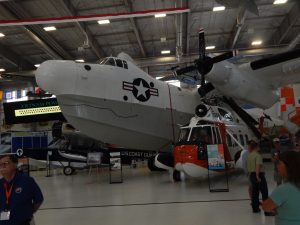
Aviation history
Aviation and in particular the National Naval Aviation Museum located on the Pensacola Naval Air Station was on my agenda.
It was only a couple of weeks ago but circumstances brought about a trip to Pensacola, Florida just as the predictions of snow for Eastern Washington were starting to fall faster than the actual flakes.
The trip was the result of a long planned and much anticipated wedding, successfully carried out on a beach with deep blue waters, gently rolling waves and a warm bright sky.
With temperatures in the 70’s and 80’s, but much higher humidity, it was something of a pleasure to explore a city with a long and diverse heritage.
Downtown is a delight to stroll through with a broad mix of Spanish Colonial, French and Old South architecture and a grand assortment of dining establishments to explore. A recent archeological dig has unearthed the site of the original, and eventually failed, Spanish settlement. The dig includes several shipwrecks dating to the 1500’s. Hurricanes and isolation eventually forced the settlers away. Later, they would establish St. Augustine, Florida as the oldest city in North America.
Aviation Museum
All of which is a back story and digression to the crown jewel of the area. The National Naval Aviation Museum located on the Pensacola Naval Air Station.
Open daily it provides the history of Naval Aviation from the earliest floatplanes to the most modern jets. The base is the home for the Blue Angles flight team which, as they were in residence during my visit, could be seen practicing their precision flying performance. They are a thrilling sight as they dance across the sky.
Two buildings, the original Hangar Bay One and the newer exhibition hall make up one of the largest aviation museums in the world. With more than 150 restored aircraft it needs to be big. Aircraft on display includes the earliest airplanes in service through versions of current aircraft still in use today. An Apollo Moon Lander is on display as is a version of the Presidential Helicopter, Marine One.
Ship models, focusing on the aircraft carriers from World War II through the present day are featured as is a display of the flight deck of a carrier from WW II. Aircraft are parked and suspended by time period to show the relationships of functions. Fighters, bombers, scouts. Several Japanese and German aircraft from that war are also on display.
Not to be left out, there is a large display of US Coast Guard aircraft. Many of these are sea, or float planes from the earliest days of search and rescue. Helicopters, from the earliest which were powered by left over engines from tanks all the way through the current Seahawk rest in easy repose.
In some ways, if you can find that quiet corner, you can feel the wind across the deck, hear the engines roaring to life and feel the seas move beneath you.
Or, you could go into one of the motion based 3D flight simulators or the virtual carrier deck giant screen theater and feel all of that for real. I passed, I know my limitations.
I also cheated by having a retired Marine aviator as a guide. He had flown a number of the aircraft on display and had a sometimes pithy remark about several. It brought everything to life in a much greater detail.
Since no visit to the Gulf is complete without a trip to the beach I went to the Gulf Islands National Seashore. Covering nearly 80 miles of protected seashore it is a natural haven for waterfowl and beach combers alike. At Pensacola, to add some history to the flavors already taken, I visited Fort Pickens located on the Western end of Santa Rosa Island.
Built before the Civil War it remained in Union hands throughout and withstood several attempts at siege by the Confederates. Several features are of interest. It took 21.5 million bricks to build. Built on sand used a reverse arch. That is an arch above ground to support and distribute the weight of the structure to the foundation piers but which included an below surface arch of bricks to distribute the entire weight of the structure so it in effect, floats on the sand. There is an area in the walls which has been exposed to show this unique construction.
Returning home I had found a new appreciation of the Florida coast but there’s no snow, even if the beaches are white, sugar sand. By now, the great drought is beginning to break and much needed rain is expected. It’ll be welcome, even as the Northwest welcomes a new season of winter play.
Written by Robert Morthorst